Ijraset Journal For Research in Applied Science and Engineering Technology
- Home / Ijraset
- On This Page
- Abstract
- Introduction
- Conclusion
- References
- Copyright
Spectral and Transmittance Properties of Er3+ Doped Zinc Lithium Lead Calcium Borophosphate Glasses
Authors: S. L. Meena
DOI Link: https://doi.org/10.22214/ijraset.2021.39135
Certificate: View Certificate
Abstract
Zinc lithium lead calcium borophosphate glasses containing Er3+ in (40-x):P2O5:10ZnO:10Li2O:10PbO:10CaO:20B2O3:xEr2O3 (where x=1, 1.5,2 mol %) have been prepared by melt-quenching method. The amorphous nature of the glasses was confirmed by x-ray diffraction studies. Optical absorption, Excitation, fluorescence and Transmittance spectra were recorded at room temperature for all glass samples. Judd-Ofelt intensity parameters ?? (?=2, 4, 6) are evaluated from the intensities of various absorption bands of optical absorption spectra. Using these intensity parameters various radiative properties like spontaneous emission probability, branching ratio, radiative life time and stimulated emission cross–section of various emission lines have been evaluated.
Introduction
I. INTRODUCTION
Rare-earth ions-doped luminescent materials have wide range of applications in which white light emitting diodes, solar cells, lasers, infrared to visible up-converters and optical communications. Oxide glasses are the most stable host matrices for practical applications due to their high chemical durability and thermal stability [1-8].Among these hosts, the borophosphate system is attractive due to its superior physical, structural and optical properties compared to pure phosphate or borate system [9-13].The low nonlinear dispersion of the highly rare-earth doped phosphate glasses enables their use in high power applications. Modification of phosphate glass with ZnO had improved glass durability while maintaining low glass transition temperature. Addition of borate in to phosphate glass also increase its durability and created a well-known glass system, namely borophosphate glass.The addition of PbO to the phosphate glass is prediectable to increase the glass stability versus devitrification and the glass becomes chemically inactive,due to the capability of PbO to turn as a modifier with structure units PbO6[14,15 ].Among different rare –earth ions, the Er3+ ion has been identified as the most efficient ion for obtaining the lasing action, frequency up-conversion and optical fiber amplification[ 16-20]. The present work reports on the preparation and characterization of rare earth doped heavy metal oxide (HMO) glass systems for lasing materials. I have studied on the absorption, emission and Transmittance properties of Er3+ doped zinc lithium lead calcium borophosphate glasses. The intensities of the transitions for the rare earth ions have been estimated successfully using the Judd-Ofelt theory, The laser parameters such as radiative probabilities(A),branching ratio (β), radiative life time(τR) and stimulated emission cross section(σp) are evaluated using J.O.intensity parameters( Ωλ, λ=2,4 and 6).
II. EXPERIMENTAL TECHNIQUES
A. Preparation of Glasses
The following Er3+ doped zinc lithium lead calcium borophosphate glass samples (40-x):P2O5:10ZnO:10Li2O:10PbO:10CaO:20B2O3: xEr2O3 (where x=1, 1.5.2) have been prepared by melt-quenching method. Analytical reagent grade chemical used in the present study consist of P2O5, ZnO, Li2O,PbO, CaO , B2O3and Er2O3. All weighed chemicals were powdered by using an Agate pestle mortar and mixed thoroughly before each batch (10g) was melted in alumina crucibles in silicon carbide based an electrical furnace.
Silicon Carbide Muffle furnace was heated to working temperature of 10500C, for preparation of zinc lithium lead calcium borophosphate glasses, for two hours to ensure the melt to be free from gases. The melt was stirred several times to ensure homogeneity. For quenching, the melt was quickly poured on the steel plate & was immediately inserted in the muffle furnace for annealing. The steel plate was preheated to1000C.While pouring; the temperature of crucible was also maintained to prevent crystallization. And annealed at temperature of 3500C for 2h to remove thermal strains and stresses. Every time fine powder of cerium oxide was used for polishing the samples. The glass samples so prepared were of good optical quality and were transparent. The chemical compositions of the glasses with the name of samples are summarized in Table 1
Table 1 Chemical composition of the glasses
Sample Glass composition (mol %)
ZLLCBP (UD) 40P2O5:10ZnO:10Li2O:10PbO:10CaO:20B2O3
ZLLCBP (ER 1) 39P2O5:10ZnO:10Li2O:10PbO:10CaO:20B2O3:1 Er2O3
ZLLCBP (ER 1.5) 38.5P2O5:10ZnO:10Li2O:10PbO:10CaO:20B2O3: 1.5 Er2O3
ZLLCBP (ER 2) 38P2O5:10ZnO:10Li2O:10PbO:10CaO:20B2O3: 2 Er2O3
ZLLCBP (UD)—Represents undoped zinc lithium lead calcium borophosphate glass specimen.
ZLLCBP (ER) -Represents Er 3+ doped zinc lithium lead calcium borophosphate glass specimens.
III. THEORY
A. Oscillator Strength
The intensity of spectral lines are expressed in terms of oscillator strengths using the relation [21].

where, ε (ν) is molar absorption coefficient at a given energy ν (cm-1), to be evaluated from Beer–Lambert law.
Under Gaussian Approximation, using Beer–Lambert law, the observed oscillator strengths of the absorption bands have been experimentally calculated, using the modified relation [22].

where c is the molar concentration of the absorbing ion per unit volume, I is the optical path length, logI0/I is absorbtivity or optical density and Δυ1/2 is half band width.
B. Judd-Ofelt Intensity Parameters
According to Judd [23] and Ofelt [24] theory, independently derived expression for the oscillator strength of the induced forced electric dipole transitions between an initial J manifold ?4fN (S, L) J> level and the terminal J' manifold ?4fN (S' ,L') J' > is given by:

In the above equation m is the mass of an electron, c is the velocity of light, ν is the wave number of the transition, h is Planck’s constant, n is the refractive index, J and J' are the total angular momentum of the initial and final level respectively, Ωλ (λ = 2, 4 and 6) are known as Judd-Ofelt intensity parameters.
C. Radiative Properties
The Ωλ parameters obtained using the absorption spectral results have been used to predict radiative properties such as spontaneous emission probability (A) and radiative life time (τR), and laser parameters like fluorescence branching ratio (βR) and stimulated emission cross section (σp).
The spontaneous emission probability from initial manifold ?4fN (S', L') J' > to a final manifold ?4fN (S, L) J >| is given by:
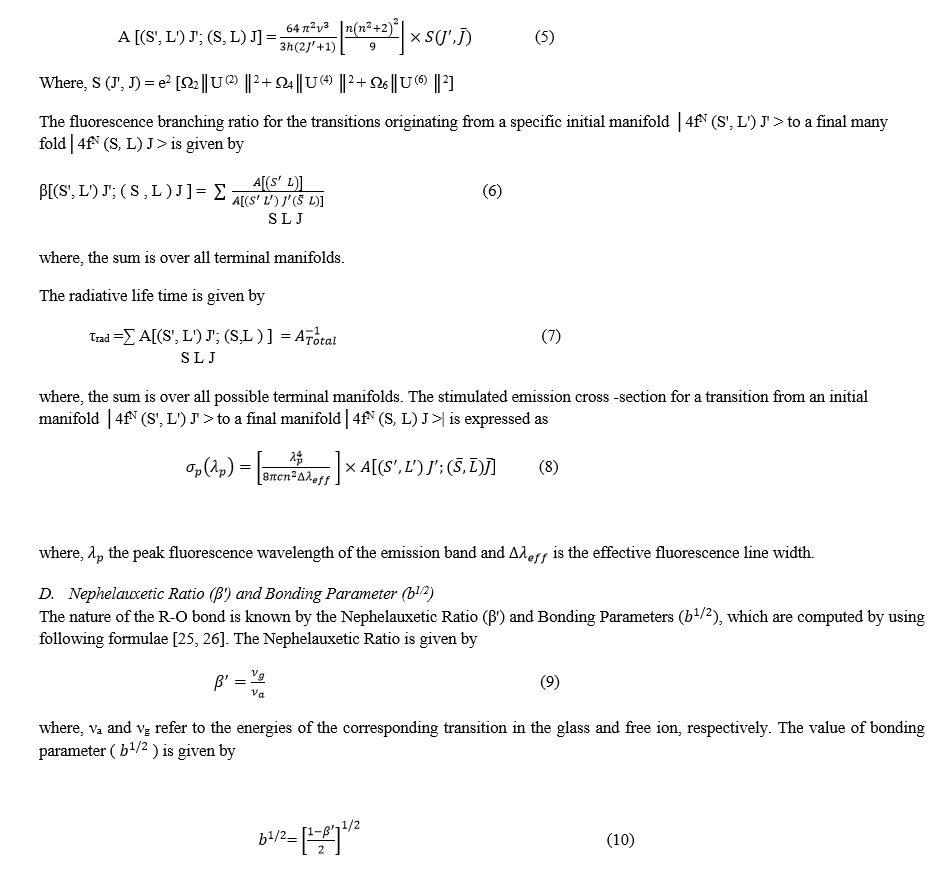
IV. RESULT AND DISCUSSION
A. XRD Measurement
Figure 1 presents the XRD pattern of the samples containing show no sharp Bragg’s peak, but only a broad diffuse hump around low angle region. This is the clear indication of amorphous nature with in the resolution limit of XRD instrument.
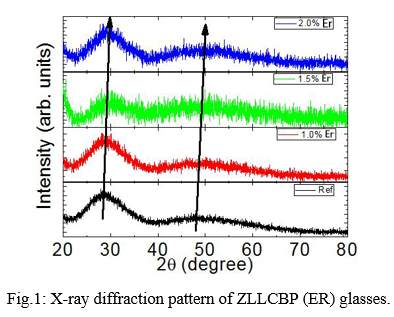
B. Transmittance Spectrum
The Transmittance spectrum of Er3+doped in zinc lithium lead calcium borophosphate glass is shown in Figure 2.
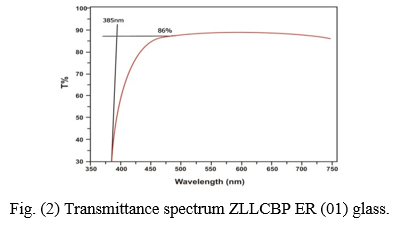
C. Absorption Spectra
The absorption spectra of ZLLCBP ER (01) glass, consists of absorption bands corresponding to the absorptions from the ground state 4I15/2 of Er3+ ions. Ten absorption bands have been observed from the ground state 4I15/2 to excited states 4I11/2, 4I9/2, 4F9/2, 4S3/2, 2H11/2, 4F7/2, 4F5/2, 4F3/2, 2H9/2 and 4G11/2 for Er3+ doped ZLLCBP ER (01) glass.
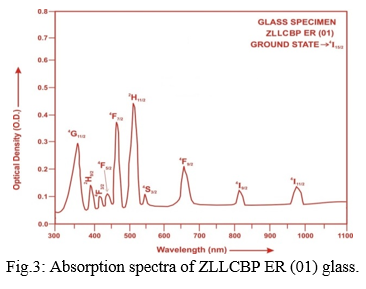
The experimental and calculated oscillator strengths for Er3+ ions in zinc lithium lead calcium borophosphate glasses are given in Table 2
Table 2. Measured and calculated oscillator strength (Pm × 10+6) of Er3+ ions in ZLLCBP glasses.
|
Energy level 4I15/2 |
Glass ZLLCBP (ER01) |
|
Glass ZLLCBP (ER1.5) |
|
Glass ZLLCBP (ER02) |
|
|
|
Pexp. |
Pcal. |
Pexp. |
Pcal. |
Pexp. |
Pcal. |
|
4I11/2 |
0.85 |
0.75 |
0.82 |
0.75 |
0.79 |
0.75 |
|
4I9/2 |
0.47 |
0.15 |
0.42 |
0.15 |
0.40 |
0.15 |
|
4F9/2 |
2.48 |
1.60 |
2.44 |
1.59 |
2.41 |
1.59 |
|
4S3/2 |
0.35 |
0.68 |
0.31 |
0.69 |
0.27 |
0.68 |
|
2H11/2 |
6.45 |
2.37 |
6.42 |
2.37 |
6.39 |
2.38 |
|
4F7/2 |
5.65 |
2.36 |
5.62 |
2.38 |
5.58 |
2.36 |
|
4F5/2 |
0.65 |
0.86 |
0.61 |
0.87 |
0.57 |
0.87 |
|
4F3/2 |
0.31 |
0.53 |
0.26 |
0.54 |
0.23 |
0.53 |
|
2H9/2 |
1.66 |
1.01 |
1.61 |
1.02 |
1.59 |
0.99 |
|
4G11/2 |
4.88 |
6.94 |
4.81 |
6.95 |
4.78 |
6.95 |
|
R.m.s.deviation |
1.8233 |
|
1.8147 |
|
1.80625 |
|
The various energy interaction parameters like Slater-Condon parameters Fk (k=2, 4, 6), Lande′ parameter ξ4f and Racah parameters Ek (k=1, 2, 3) have been computed using partial regression method . The ratio of Racah parameters E1/E3 and E2/E3 are about 10.35 and 0.049 respectively. Computed values of Slater-Condon, Lande′, Racah, nephelauexetic ratio and bonding parameter for Er3+ doped ZLLCBP glass specimens are given in Table 3.
Table3. Computed values of Slater-Condon, Lande′, Racah, nephelauexetic ratio and bonding parameter for Er3+ doped ZLLCBP glass specimens.
|
Parameter |
Free ion |
ZLLCBP ER01 |
ZLLCBP ER1.5 |
ZLLCBP ER02 |
|
|
F2(cm-1) |
441.680 |
433.918 |
433.907 |
433.904 |
|
|
F4(cm-1) |
68.327 |
67.045 |
67.048 |
67.046 |
|
|
F6(cm-1) |
7.490 |
7.042 |
7.043 |
7.041 |
|
|
ξ4f(cm-1) |
2369.400 |
2414.744 |
2414.726 |
2414.774 |
|
|
E1(cm-1) |
6855.300 |
6662.232 |
6662.304 |
6661.928 |
|
|
E2(cm-1) |
32.126 |
31.342 |
31.340 |
31.339 |
|
|
E3(cm-1) |
645.570 |
643.678 |
643.652 |
643.686 |
|
|
F4/F2 |
0.15470 |
0.15451 |
0.15452 |
0.15452 |
|
|
F6/F2 |
0.01696 |
0.016229 |
0.016231 |
0.016227 |
|
|
E1/E3 |
10.61899 |
10.350263 |
10.351 |
10.350 |
|
|
E2/E3 |
0.049764 |
0.04869185 |
0.048691 |
0.048687 |
|
|
β' |
|
0.9956098 |
0.9956340 |
0.9955572 |
|
|
b1/2 |
|
0.04685173 |
0.0467231 |
0.04713154 |
|
|
|
|||||
Judd-Ofelt intensity parameters Ωλ (λ = 2, 4 and 6) were calculated by using the fitting approximation of the experimental oscillator strengths to the calculated oscillator strengths with respect to their electric dipole contributions. In the present case the three Ωλ parameters follow the trend Ω4 < Ω2 < Ω6.
The values of Judd-Ofelt intensity parameters are given in Table 4.
Table 4. Judd-Ofelt intensity parameters for Er3+ doped ZLLCBP glass specimens.
|
Glass Specimen |
?2(pm2) |
?4(pm2) |
?6(pm2) |
?4/?6 |
|
|
ZLLCBP (ER01) |
0.7524 |
0.3016 |
0.9877 |
0.305 |
|
|
ZLLCBP (ER1.5) |
0.7605 |
0.2876 |
0.9975 |
0.288 |
|
|
ZLLCBP (ER02) |
0.7618 |
0.2890 |
0.9899 |
0.292 |
D. Excitation Spectrum
The Excitation spectra of Er3+doped ZLLCBP glass specimens have been presented in Figure 4 in terms of Excitation Intensity versus wavelength. The excitation spectrum was recorded in the spectral region 300–600 nm fluorescence at 550nm having different excitation band centered at 350,365, 381, 425, 450, 470and 515 nm are attributed to the 2K15/2, 4G9/2, 4G11/2, 2G9/2, 4F3/2, 4F5/2 and 2H11/2 transitions, respectively. The highest absorption level is 4G11/2and is at 381nm.So this is to be chosen for excitation wavelength.
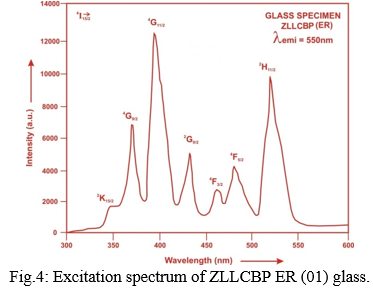
E. Fluorescence Spectrum
The fluorescence spectrum of Er3+doped in zinc lithium lead calcium borophosphate glass is shown in Figure 5. There are six broad bands (4F7/2→4I15/2), (2H11/2→4I15/2),(4S3/2→4I15/2),(4F9/2→4I15/2),(4I11/2→4I15/2)and(4I13/2→4I15/2)respectively for glass specimens.

Table 5. Emission peak wave lengths (λp), radiative transition probability (Arad), branching ratio (βR), stimulated emission crosssection (σp), and radiative life time (τ) for various transitions in Er3+ doped ZLLCBP glasses.
|
Transition |
|
ZLLCBP ER 01 |
ZLLCBP ER 1.5 |
ZLLCBP ER 02 |
|||||||||
|
λmax (nm) |
Arad(s-1) |
β |
σp (10-20 cm2) |
τR(μs) |
Arad(s-1) |
β |
σp(10-20 cm2) |
τR (μs) |
Arad(s-1) |
β |
σp (10-20 cm2) |
τR (10-20 cm2) |
|
|
4F7/2→4I15/2 |
485 |
2471.07 |
0.4203 |
0.5988 |
|
2491.04 |
0.4209 |
0.5861 |
|
2478.91 |
0.4202 |
0.5616 |
|
|
2H11/2→4I15/2 |
530 |
1354.28 |
0.2303 |
0.3790 |
1357.81 |
0.2294 |
0.3739 |
1361.11 |
0.2307 |
0.3635 |
|||
|
4S3/2→4I15/2 |
550 |
1097.11 |
0.1866 |
0.2917 |
170.07 |
1110.77 |
0.1877 |
0.2910 |
168.99 |
1104.47 |
0.1872 |
0.2819 |
169.51 |
|
4F9/2→4I15/2 |
657 |
729.66 |
0.1241 |
0.3442 |
|
727.66 |
0.1230 |
0.3372 |
|
725.79 |
0.1230 |
0.3304 |
|
|
4I11/2→4I15/2 |
990 |
125.73 |
0.0214 |
0.3854 |
|
127.23 |
0.0215 |
0.3840 |
|
126.57 |
0.0215 |
0.3683 |
|
|
4I13/2→4I15/2 |
1538 |
102.12 |
0.0174 |
1.3517 |
|
103.18 |
0.0174 |
1.3427 |
|
102.65 |
0.0174 |
1.2994 |
|
Conclusion
In the present study, the glass samples of composition (40-x):P2O5:10ZnO:10Li2O:10PbO:10CaO:20B2O3:xEr2O3 (where x =1, 1.5, 2 mol %) have been prepared by melt-quenching method. The value of stimulated emission cross-section (?p) is found to be maximum for the transition (4I13/2?4I15/2) for glass ZLLCBP (ER 01), suggesting that glass ZLLCBP (ER 01) is better compared to the other two glass systems ZLLCBP (ER1.5) and ZLLCBP (ER02).
References
Shoaib, M., Chanthima, N., Rooh, G., Rajaramakrishna, R. and Kaewkhao,J.(2019).Physical and luminescence properties of rare earth doped phosphate glasses for solid state lighting applications. Thai interdisciplinary research, 14, 3, 20 – 26. Swapna,K.,Mahamuda,S.,Venkateswarlu,M.,SrinivasaRao,A.,Jayasimhadri,M.,Shakya,S.andPrakash,G.V.(2015).Up-conversion and NIR(~1.5µm) luminescence studies of Er3+ doped zinc alumina bismuth borate glasses,J. Lumin.163,55-63. Wantana, N.(2017). Energy transfer from Gd3+ to Sm3+ and luminescence characteristics of CaO–Gd2O3–SiO2– B2O3 scintillating glasses, J. Lumin., 181, 382–386. Campbell, J.H.and Suratwala, T.I. (2000). Nd3+-doped phosphate glasses for high-energy/high-peak-power lasers.J. Non-Cryst. Solids, 263, 318–341. Gaël, P., Cassanjes, F. C.,de Araújo, Cid B., Jerez, Vladimir A. , Ribeiro, Sidney J. L., Messaddeq,Y.and Poulain,M.(2003). Optical properties andfrequency upconversion fluorescence in a Tm3+ -doped alkaliniobium tellurite glass.AIP Journal of Applied Physics 93, 3259. Meena, S.L. (2017).Spectroscopic Properties of Eu3+Doped in Yttrium Zinc Lithium Bismuth Borate Glasses. The Int.J. Eng. and Scie. (IJES),6 , 10 , 30-36 . Narayanan, M.K. and Shashikala, H.D.(2015). Thermal and optical properties of BaO-CaF2-P2O5 glasses, J. Non-Cryst. Solids, 422, 6-11. Reddi Babua , M., Mohan Babua, A. and Rama Moorthy, L.(2018).Structural and optical properties of Nd3+- doped lead borosilicate glasses for broadband laser amplification, International Journal of Applied Engineering Research ,13, 10, 7692-7700. Guan, P. X., Yew, E. T., Ming , L. P., Shamsuri, W. N. W.and Hussin, R.(2014).Structural and Luminescence Study of Rare Earth and Transition Metal Ions Doped Lead Zinc Borophosphate Glasses, Adv. Mat. Res.895,280-283. Rohaizad,A.,Hussin,R.,Aziz,N.A.S.,Uning,R.andBohari,N.Z.I.(2013). Vibrational Studies of Zinc Antimony Borophosphate Glasses Doped Rare Earth,J.Tek.(Sci. and Eng.),62(3),119-122. Kumar,G.R. and Rao,C.S.(2020).Influence of Bi2O3, Sb2O3 and Y2O3 on optical properties of Er2O3-doped CaO–P2O5–B2O3 glasses, , Bull. Mater. Sci. 43:71,1-7. Pang,X.G.,Eeu,T.Y.,Leong,P.M.,Shamsuri,W.N.W.andHussin,R.(2014).Structural and Luminescence Study of Rare Earth and Transition Metal Ions Doped Lead Zinc Borophosphate Glasses,Adv.Mat.Res.,895,280-283. S.L.Meena (2020).Spectral and Thermal Properties of Ho3+ Doped in Zinc Lithium Alumino Antimony Borophosphate Glasses, IJSDR 5 (11),127-133. Salem, S.M. and Mohamed, E.A. (2011).Electrical conductivity and dielectric properties of Bi2O3-GeO2-PbO-MoO3 glasses,J. Non-Cryst.Solids,357,1153-1159. Reis,S.T.,Faria,D.,Martinelli,J.R.,Pontuschka,W.M.,Day,D.E.andParititi,C.(2002).Structural features of lead iron phosphate glasses,J.Non-Cryst. Solids, 304,188-194 Yannick L., Mohammed El Amradoui, Jefferson L Ferrari, Pier-Luc Fortin, Sidney R. and Youne Messaddeq(2013).Infrared to Visible Up-Conversion Emission in Er3+/ Yb3+ codoped Fluoro phosphate Glass Ceramics, J. American Ceramic Society 96(3),825-832. Dousti, M.R., Poirier, G.Y.and de Camargo, A.S.S. de,(2020).Tungsten Sodium Phosphate glasses doped with trivalent rare earth ions (Eu3+, Tb3+, Nd3+, Er3+ ) for visible and near infrared applications, Journal of Non- Crystalline Solids 530, 119838. Bosca,M., Pop, L., Borodi, G., Pascuta, P.and Culea, E.(2009).XRD and FTIR structural investigations of Erbium doped Bismuth lead silver glasses and glass ceremics, Journal of Alloys and Compounds. Dutebo, M. T.and Shashikala, H.D.(2020).Influence of (Er3+, La3+, Ce4+) additions on physical and optical properties of 50 CaO- 50 P2O5 glasses,Physica B: Condensed Matter 597, 412358. Zhang,J., Wang, N., Guo, Y., Cai, M., Tian, Y., Huang, F.and Xu, S.(2018). Tm3+ doped lead silicate glass sensitized by Er3+ for efficient ~2 ?m mid infrared laser material, Spectrochmica Acta Part A : Molecular and Biomolecular Spectroscopy 199, 65-70. Gorller-Walrand, C. and Binnemans, K. (1988). Spectral Intensities of f-f Transition. In: Gshneidner Jr., K.A. and Eyring, L., Eds., Handbook on the Physics and Chemistry of Rare Earths, Vol. 25, Chap. 167, North-Holland, Amsterdam, 101. Sharma, Y.K., Surana, S.S.L. and Singh, R.K. (2009). Spectroscopic Investigations and Luminescence Spectra of Sm3+ Doped Soda Lime Silicate Glasses. Journal of Rare Earths, 27, 773. Judd, B.R. (1962). Optical Absorption Intensities of Rare Earth Ions. Physical Review, 127, 750. Ofelt, G.S. (1962). Intensities of Crystal Spectra of Rare Earth Ions. The Journal of Chemical Physics, 37, 511. Sinha, S.P. (1983). Systematics and properties of lanthanides, Reidel, Dordrecht. Krupke, W.F. (1974).IEEE J. Quantum Electron QE, 10,450.
Copyright
Copyright © 2022 S. L. Meena. This is an open access article distributed under the Creative Commons Attribution License, which permits unrestricted use, distribution, and reproduction in any medium, provided the original work is properly cited.

Download Paper
Paper Id : IJRASET39135
Publish Date : 2021-11-27
ISSN : 2321-9653
Publisher Name : IJRASET
DOI Link : Click Here
 Submit Paper Online
Submit Paper Online

